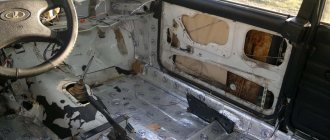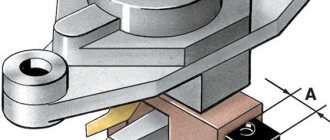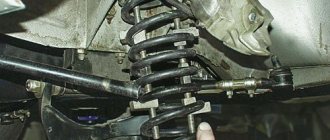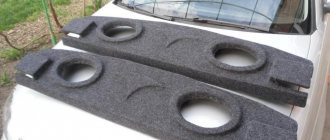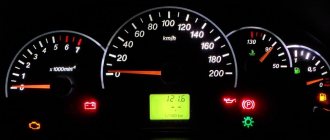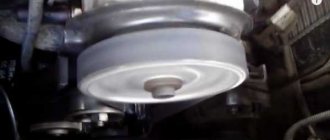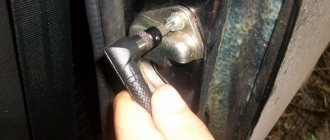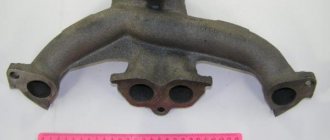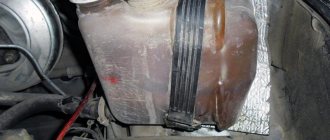Car audio: how to correctly determine the speaker size
Are you thinking about changing the speakers in your car, but don't know if the new speakers are the right size? In fact, everything is not as complicated as it seems at first glance. In the vast majority of cases, speakers, even standard ones, have standard sizes, Pioneer Russia writes on Facebook.
Experts note that the most popular “calibers” are 10 cm (4 inches), 13 cm (5.25 inches), 16.5 cm (6.5 inches) and oval speakers measuring 6x9 inches. There are, of course, less common ones like 6-inch or 4x7 inches, but they are much less common.
To determine the caliber of speakers in your car, simply remove the panel to get to them. It must be remembered that the size is determined not by the diameter of the diffuser, but by the outer diameter of the speaker itself. There is no need to measure everything with millimeter accuracy, because the caliber of the speakers is a nominal value, the physical dimensions may differ slightly. Having determined this size, you can safely choose new speaker systems.
The size of the speakers is usually reflected in the model name. In Pioneer speaker systems, for example, TS-G1021F are 10 cm speakers, and TS-G1320F are 13 cm. As for the size of 16.5 cm (6.5 inches), sometimes the names may include the numbers 65, 165 or 17. This means that with a standard mounting size, the speaker has a larger diffuser, which means, other things being equal, it has higher sensitivity and works more confidently at lower frequencies. Like, for example, Pioneer TS-A1733I.
“And the last moment. When choosing new speaker systems to replace, pay attention to the holes for mounting the speakers. Many Pioneer models have a universal set of holes that allows you to easily install speakers in most standard places. But don't be upset if it suddenly turns out that the stock speakers have their own complex shape. For such cases, you can find adapter rings for sale for specific car models that will solve this problem,” experts note.
High-quality sound in a car depends on many factors, from the choice of radio to the size and location of the speakers. This material will help you find out which is better to install car speakers - 10, 13 or 16 cm. Only if all basic requirements are met, the driver will be able to achieve the highest quality sound.
Types of speaker systems
Before choosing 10, 13 or 16 cm speakers for your car, let's figure out what types of speaker systems exist and how they differ from each other.
Today there are three main types of acoustic systems:
- broadband;
- coaxial;
- component.
This order was not chosen by chance - it is in accordance with it that acoustics increase in reproduction quality, installation complexity and, of course, cost. In the wideband version, one speaker reproduces the entire frequency range. In fact, this is only enough for listening to news on a radio station or turning on a low background while driving. Currently, most automobile manufacturers equip their vehicles with this type of acoustics during production.
ArtSound speakers for the car
If you value truly good sound, then to obtain it, such acoustics can be replaced with coaxial ones, which literally means coaxial. In this case, several columns of 13, 10, 16 cm or other sizes installed on the same axis can be used. The frequency range reproduced by the audio system is divided into low, medium and high. To ensure better sound quality, different devices are used for individual ranges.
In total, up to five such speakers (13, 10 or 20 cm) can be installed (but not less than two), but in most cases, a three-way system is used in domestic cars. That is, if the speaker size is 13 centimeters and it is the largest among the others, then it will be a low-frequency device. And in front of its diffuser, mid- and high-frequency speakers should be mounted. It is thanks to separation that the range of reproduced frequencies generally increases, and the sound quality improves.
It should be noted that the sound quality in general is facilitated by the correct separation of channels, as well as the absence of distortion. As for channel separation, a special crossover element is responsible for this, which is a filter that can contain from 1 to 4 stages. In simpler speaker systems, crossovers are installed in the car speakers themselves. If the system itself is of a higher quality, it will use an external crossover, which looks like a block, and in some cases it can be used to adjust the signals.
Column mounted on a stand and tweeter
As for the component options, in them the sound range is similarly divided by frequency, only in this case the speakers are scattered throughout the space, they are all installed separately. Of course, this significantly increases the complexity, as well as the cost of installation, but nevertheless, in the end, almost ideal and surround sound can be achieved. Component systems are widely used among connoisseurs of high-quality sound.
To ensure the loudest and, importantly, high-quality playback of low ranges, none of these types of systems are suitable. To ensure high-quality low-frequency sound, only subwoofers can be used. This type of device belongs to rear speakers; subwoofers are usually installed in the trunk.
Measuring Thiel-Small parameters at home
Attention! The article is not relevant! The entire measurement procedure is described here.
Most parameters for the manufacture of acoustic design can be measured or calculated at home using not particularly sophisticated measuring instruments and a computer or calculator that can extract roots and raise to a power. The author of this “work” does not claim any special knowledge in the field of theory, and everything presented here is a compilation from various sources - both foreign and Russian.
The most basic parameters by which you can calculate and manufacture an acoustic design (in other words, a box) are:
- Speaker Resonance Frequency Fs (Hertz)
- Equivalent volume Vas (liters or cubic feet)
- Full quality Qts
- DC resistance Re (Ohm)
For a more serious approach, you will also need to know:
- Mechanical quality factor Qms
- Electrical quality factor Qes
- Diffuser area Sd (m2) or diameter Dia (cm)
- Sensitivity SPL (dB)
- Inductance Le (Henry)
- Impedance Z (Ohm)
- Peak power Pe (Watt)
- Mass of the moving system Mms (g)
- Relative hardness Cms (meters/newton)
- Mechanical resistance Rms (kg/sec)
- Motor power BL
Measurement of Re, Fs, Fc, Qes, Qms, Qts, Qtc, Vas, Cms, Sd.
To measure these parameters, you will need the following equipment: 1. Voltmeter 2. Audio frequency signal generator 3. Frequency meter 4. Powerful (at least 5 watts) resistor with a resistance of 1000 ohms 5. Accurate (+ - 1%) resistor with a resistance of 10 ohms 6. Wires, clamps and other rubbish to connect it all into a single circuit.
Of course, this list is subject to change. For example, most generators have their own frequency scale and a frequency meter is not necessary in this case. Instead of a generator, you can also use a computer sound card and corresponding software capable of generating sinusoidal signals from 0 to 200 Hz of the required power.
Scheme for measurements
Calibration: First you need to calibrate the voltmeter. To do this, instead of a speaker, a 10 Ohm resistance is connected and by selecting the voltage supplied by the generator, it is necessary to achieve a voltage of 0.01 volts. If the resistor is of a different value, then the voltage should correspond to 1/1000 of the resistance value in ohms. For example, for a 4 ohm calibration resistance, the voltage should be 0.004 volts. Remember! After calibration, the generator output voltage cannot be adjusted until all measurements are completed.
Finding Re Now, by connecting a speaker instead of a calibration resistance and setting the frequency on the generator to close to 0 hertz, we can determine its direct current resistance Re. It will be the voltmeter reading multiplied by 1000. However, Re can be measured directly with an ohmmeter.
Finding Fs and Rmax The speaker during this and all subsequent measurements must be in free space. The resonant frequency of a speaker is found at the peak of its impedance (Z-characteristic). To find it, smoothly change the frequency of the generator and look at the voltmeter readings. The frequency at which the voltage on the voltmeter will be maximum (a further change in frequency will lead to a voltage drop) will be the main resonance frequency for this speaker. For speakers with a diameter greater than 16cm, this frequency should be below 100Hz. Don't forget to record not only the frequency, but also the voltmeter readings. Multiplied by 1000, they will give the speaker resistance at the resonant frequency Rmax, necessary for calculating other parameters.
Finding Qms, Qes and Qts These parameters are found using the following formulas:
As you can see, this is a sequential finding of additional parameters Ro, Rx and measurement of previously unknown frequencies F1 and F2. These are the frequencies at which the speaker impedance is equal to Rx. Since Rx is always less than Rmax, there will be two frequencies - one is slightly less than Fs, and the other is slightly more. You can check the accuracy of your measurements with the following formula:
If the calculated result differs from the previously found one by more than 1 hertz, then you need to repeat everything all over again and more carefully. So, we have found and calculated several basic parameters and can draw some conclusions based on them: 1. If the resonant frequency of the speaker is above 50Hz, then it has the right to claim to work, at best, as a midbass. You can immediately forget about the subwoofer on such a speaker. 2. If the resonant frequency of the speaker is above 100Hz, then it is not a woofer at all. You can use it to reproduce mid frequencies in three-way systems. 3. If the Fs/Qts ratio of a speaker is less than 50, then this speaker is designed to work exclusively in closed boxes. If more than 100 - exclusively for working with a bass reflex or in bandpasses. If the value is between 50 and 100, then you need to carefully look at other parameters - what type of acoustic design the speaker gravitates towards. It is best to use special computer programs for this that can graphically simulate the acoustic output of such a speaker in different acoustic designs. True, you cannot do without other, no less important parameters - Vas , Sd, Cms and L.
What types of speakers are there?
It must be said right away that it doesn’t matter what shape the car speakers are installed in the car - round or oval - the quality is determined only by their dimensions. Device sizes are a standard that determines their dimensions. Basically, on modern cars the sizes of loudspeakers that can be installed are standard - 10 cm, 13 cm or 16 cm. The rear shelves of cars are usually equipped with connectors for installing oval speakers measuring 15x23 cm.
Four columns with different diameters
If the speaker diagonal is higher, it will be able to reproduce low frequencies better. In general, the size of the system largely depends on the size of the woofer, since it, as stated earlier, is the largest in the entire system.
- If the front speakers are 10 cm in size, then they will be able to reproduce sounds with a frequency of 120 hertz;
- with speaker dimensions of 13 cm, there will be good quality sound reproduction from 100 Hz;
- with dimensions of 16 cm, the device will be able to reproduce sounds from 80 Hz.
What size is optimal?
If your car has front-facing speakers, then it is optimal to use a 16-centimeter speaker. This diameter will allow you to achieve good sound with low bass. As a rule, speakers with this diameter can be installed in a car without problems, but in some cases the installation space may be smaller. In practice, this problem can be solved on your own or by turning to specialists at the installation center for help. It is only necessary to slightly increase the size of the standard space for mounting the loudspeaker (the author of the video is URAL Sound Russia - Official Channel).
It is worth considering one main feature that many of our compatriots neglect, in particular, we are talking about the differences between models of the same line. We are talking about speaker models characterized by advanced technical features. It should be noted that the cost of different models may not vary much.
If your vehicle is equipped with three-component acoustics, then the best option would be to use 20 cm speakers. They are especially suitable for reproducing mid-frequency ranges due to their size. However, it is the dimensions that are the main problem that may cause difficulties in installing loudspeakers, especially in the front of the car. Not so often, but still such speakers are used for two-component acoustic systems; in this case, it must be taken into account that the quality of mid-frequency playback leaves much to be desired. As practice shows, 20-centimeter speakers are most optimally suited for systems that do not have a subwoofer.
If we talk about the size of the speakers 13 cm, then they are perfect for installation in a car with a front-facing system. The best way to use 13 cm speakers is as rear devices. If there is not enough space in the vehicle interior, then 13 cm speakers can be used to equip the front system, but this may lead to too limited bass (video author - LOUD SOUND).
In coaxial acoustics, speakers with dimensions of 15x23 cm can be installed on the rear shelf; these dimensions allow you to provide the deepest low frequencies. But it should be noted that devices of this type have certain disadvantages, in particular, the quality of the coaxial design itself will be low, especially since the driver will not have the opportunity to change the subwoofer. And although such a speaker can produce deep bass, it will not be full and clear, let alone balanced tonal sound. If you like a good visual effect, then, in principle, you can find oval-sized speakers on sale that will provide it. However, in this case, the problem of choice is acute, since there are not many options.
If you don’t want to use standard acoustics because of their low quality, but at the same time you don’t have the opportunity to remodel the place to install good speakers, there is a way out. For example, you can install oval speakers whose size is 13x18 cm. As for 10-cm speakers, we do not recommend that our users fall for advertising.
Manufacturers often advertise this product as a quality product that allows you to achieve better sound, but in fact this is far from the case. Devices of this type, no matter how they are advertised, are characterized by poor playback quality in general and, even more so, poor bass. So if you purchase such speakers, the acoustics in your car must be equipped with additional low-frequency support. For example, you can use so-called midbass devices, which are best mounted in the front part of the cabin.
Of course, in terms of cost, small-sized speakers will always cost less, unlike others. However, if you want to achieve good sound, then when purchasing, you should only look at the quality of the speakers, and not at their cost. Often, car owners, trying to save money, end up with low-quality acoustics that cannot reproduce high-quality sound at high volumes.
Budget speakers for cars with good sound
In order to equip a car with good sound within a small amount, you need to use a simplified acoustics connection diagram. To do this, two-way front systems and two wideband speakers for the rear “sound system” are connected directly to the music center, without an amplifier. This scheme does not imply a large output power, so it does not matter which budget speakers are best for cars. There are many quality models in the middle category:
These two-way systems allow for high-quality sound background in the car interior. Any wideband model can be used as rear speakers. If necessary, the power is increased by adding an inexpensive amplifier. The review and rating of the best car speakers 2021 is always compiled according to separate categories. This applies to the design of dynamic heads, their technical characteristics and manufacturing companies.
Video “How to install acoustics in a car with your own hands?”
What a car owner needs to know about how to install an acoustic system in his vehicle - watch the video (the author of the video is an EXPERT Speaks).
High-quality sound in a car depends on many factors, from the choice of radio to the size and location of the speakers. This material will help you find out which is better to install car speakers - 10, 13 or 16 cm. Only if all basic requirements are met, the driver will be able to achieve the highest quality sound.
Some useful tips
Finally, we will give a few more useful recommendations that will help you make the right choice of car speakers so that you can enjoy high-quality sound:
- The suspension of the speakers should not be made of fabric, but rubber.
Silk tweeters should be used, since silk provides an even, soft and detailed sound.
The speakers need to be fixed as rigidly as possible (preferably to wood or metal).
It is imperative to soundproof your car if high-quality sound is important to you. Otherwise, the music will be drowned out by the noise of the engine and wheels.
Types of speaker systems
Before choosing 10, 13 or 16 cm speakers for your car, let's figure out what types of speaker systems exist and how they differ from each other.
Today there are three main types of acoustic systems:
- broadband;
- coaxial;
- component.
This order was not chosen by chance - it is in accordance with it that acoustics increase in reproduction quality, installation complexity and, of course, cost. In the wideband version, one speaker reproduces the entire frequency range. In fact, this is only enough for listening to news on a radio station or turning on a low background while driving. Currently, most automobile manufacturers equip their vehicles with this type of acoustics during production.
ArtSound speakers for the car
If you value truly good sound, then to obtain it, such acoustics can be replaced with coaxial ones, which literally means coaxial. In this case, several columns of 13, 10, 16 cm or other sizes installed on the same axis can be used. The frequency range reproduced by the audio system is divided into low, medium and high. To ensure better sound quality, different devices are used for individual ranges.
In total, up to five such speakers (13, 10 or 20 cm) can be installed (but not less than two), but in most cases, a three-way system is used in domestic cars. That is, if the speaker size is 13 centimeters and it is the largest among the others, then it will be a low-frequency device. And in front of its diffuser, mid- and high-frequency speakers should be mounted. It is thanks to separation that the range of reproduced frequencies generally increases, and the sound quality improves.
It should be noted that the sound quality in general is facilitated by the correct separation of channels, as well as the absence of distortion. As for channel separation, a special crossover element is responsible for this, which is a filter that can contain from 1 to 4 stages. In simpler speaker systems, crossovers are installed in the car speakers themselves. If the system itself is of a higher quality, it will use an external crossover, which looks like a block, and in some cases it can be used to adjust the signals.
Column mounted on a stand and tweeter
As for the component options, in them the sound range is similarly divided by frequency, only in this case the speakers are scattered throughout the space, they are all installed separately. Of course, this significantly increases the complexity, as well as the cost of installation, but nevertheless, in the end, almost ideal and surround sound can be achieved. Component systems are widely used among connoisseurs of high-quality sound.
To ensure the loudest and, importantly, high-quality playback of low ranges, none of these types of systems are suitable. To ensure high-quality low-frequency sound, only subwoofers can be used. This type of device belongs to rear speakers; subwoofers are usually installed in the trunk.
A little about subwoofers and amplifiers:
To obtain louder and better sound, car enthusiasts use amplifiers and subwoofers. The role of an amplifier in an audio system is to qualitatively enhance the sound level and transfer its audio frequency range to certain channels. A subwoofer is necessary if you want to get deep and correct bass from your audio system. Cars are rarely equipped with a subwoofer from the factory. Therefore, the installation of such equipment requires laying a power cable (usually from the engine compartment), as well as laying an audio cable, the so-called interconnects, from the head unit to the amplifier and then to the subwoofer.
Installing an amplifier and subwoofer is quite a complex process, with a lot of nuances, for example the basic ones:
- To avoid interference from electrical equipment, both + and – are routed from the battery to the amplifier
- interconnectors and power wires are laid along different thresholds of the car
- in case of intersection of interconnectors and the power wire, the angle between them should be 90 degrees, this will eliminate interference
- To control the power supply to the amplifier from the radio, an additional signal wire with a voltage of 5V is laid, otherwise the amplifier will drain the battery in a couple of days maximum
- etc.
What types of speakers are there?
It must be said right away that it doesn’t matter what shape the car speakers are installed in the car - round or oval - the quality is determined only by their dimensions. Device sizes are a standard that determines their dimensions. Basically, on modern cars the sizes of loudspeakers that can be installed are standard - 10 cm, 13 cm or 16 cm. The rear shelves of cars are usually equipped with connectors for installing oval speakers measuring 15x23 cm.
Four columns with different diameters
If the speaker diagonal is higher, it will be able to reproduce low frequencies better. In general, the size of the system largely depends on the size of the woofer, since it, as stated earlier, is the largest in the entire system.
- If the front speakers are 10 cm in size, then they will be able to reproduce sounds with a frequency of 120 hertz;
- with speaker dimensions of 13 cm, there will be good quality sound reproduction from 100 Hz;
- with dimensions of 16 cm, the device will be able to reproduce sounds from 80 Hz.
What size is optimal?
If your car has front-facing speakers, then it is optimal to use a 16-centimeter speaker. This diameter will allow you to achieve good sound with low bass. As a rule, speakers with this diameter can be installed in a car without problems, but in some cases the installation space may be smaller. In practice, this problem can be solved on your own or by turning to specialists at the installation center for help. It is only necessary to slightly increase the size of the standard space for mounting the loudspeaker (the author of the video is URAL Sound Russia - Official Channel).
It is worth considering one main feature that many of our compatriots neglect, in particular, we are talking about the differences between models of the same line. We are talking about speaker models characterized by advanced technical features. It should be noted that the cost of different models may not vary much.
If your vehicle is equipped with three-component acoustics, then the best option would be to use 20 cm speakers. They are especially suitable for reproducing mid-frequency ranges due to their size. However, it is the dimensions that are the main problem that may cause difficulties in installing loudspeakers, especially in the front of the car. Not so often, but still such speakers are used for two-component acoustic systems; in this case, it must be taken into account that the quality of mid-frequency playback leaves much to be desired. As practice shows, 20-centimeter speakers are most optimally suited for systems that do not have a subwoofer.
If we talk about the size of the speakers 13 cm, then they are perfect for installation in a car with a front-facing system. The best way to use 13 cm speakers is as rear devices. If there is not enough space in the vehicle interior, then 13 cm speakers can be used to equip the front system, but this may lead to too limited bass (video author - LOUD SOUND).
In coaxial acoustics, speakers with dimensions of 15x23 cm can be installed on the rear shelf; these dimensions allow you to provide the deepest low frequencies. But it should be noted that devices of this type have certain disadvantages, in particular, the quality of the coaxial design itself will be low, especially since the driver will not have the opportunity to change the subwoofer. And although such a speaker can produce deep bass, it will not be full and clear, let alone balanced tonal sound. If you like a good visual effect, then, in principle, you can find oval-sized speakers on sale that will provide it. However, in this case, the problem of choice is acute, since there are not many options.
If you don’t want to use standard acoustics because of their low quality, but at the same time you don’t have the opportunity to remodel the place to install good speakers, there is a way out. For example, you can install oval speakers whose size is 13x18 cm. As for 10-cm speakers, we do not recommend that our users fall for advertising.
Manufacturers often advertise this product as a quality product that allows you to achieve better sound, but in fact this is far from the case. Devices of this type, no matter how they are advertised, are characterized by poor playback quality in general and, even more so, poor bass. So if you purchase such speakers, the acoustics in your car must be equipped with additional low-frequency support. For example, you can use so-called midbass devices, which are best mounted in the front part of the cabin.
Of course, in terms of cost, small-sized speakers will always cost less, unlike others. However, if you want to achieve good sound, then when purchasing, you should only look at the quality of the speakers, and not at their cost. Often, car owners, trying to save money, end up with low-quality acoustics that cannot reproduce high-quality sound at high volumes.
Related questions
Is it possible to mix speaker brands?
Mixing brands is not recommended. Each speaker has a unique timbre, which is a sound signature. Using two different speakers creates two tones that conflict with each other. Even different models or product lines of the same brand can create the same effect. It gets even more chaotic when you have a full surround sound system with more than two speakers - for example, you might have multiple front speakers and surround speakers in the back or on the sides. If they all have different tones because they are all from different brands, all you can hear is a chaotic mess. It's always better to have a matching set since they are designed to work together.
How far apart should the speakers be from each other for best performance?
The optimal distance between speakers will depend on how your room is laid out. You want it to be proportional to the distance between any listening position and the speakers. For example, if you're using them for a home theater and your chair is seven feet from the TV, the speakers should be about seven feet apart. Your chair should form an equilateral triangle with the speakers.
How to set up a room for the best sound?
For best sound, tilt the speakers slightly toward your seat. Avoid placing speakers close to a wall, as this will cause sound to bounce off the wall and distort the sound you hear. If you place a chair against a wall, there will be less room for sound to travel and surround you, resulting in a less immersive experience. This also causes the sound to bounce off the wall behind you, resulting in more distortion. For best results, move the chair and speakers slightly further into the room. Make sure your equilateral triangle is still in place.
Recording source: https://thehometheaterdiy.com

